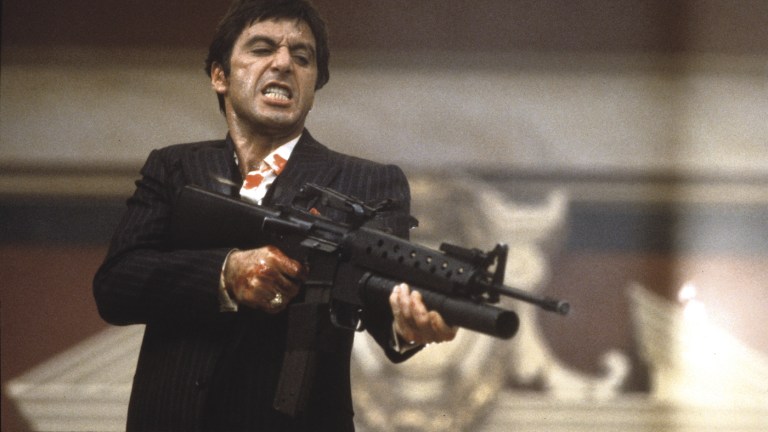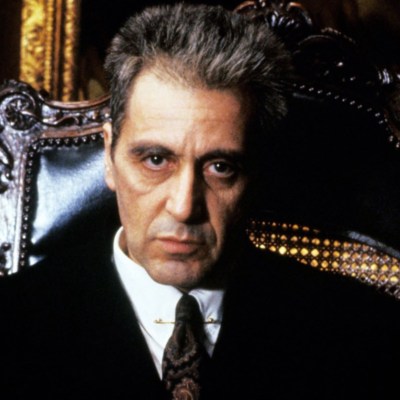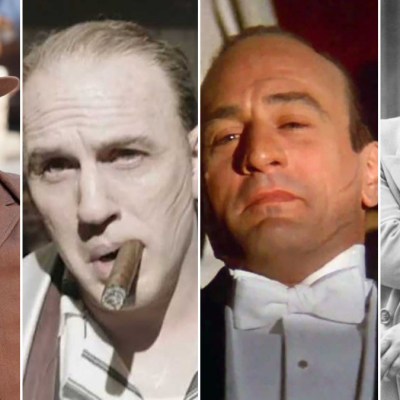Scarface: Where Tony Montana Went Wrong
Tony Montana had the world and everything in it, but he blew off good advice and created his own downfall. Not every dog gets his day in Brian De Palma's Scarface.

“All I have in this world is my balls and my word, and I don’t break them for no one,” Tony Montana declares in the 1983 gangster classic, Scarface. Yet Al Pacino’s antihero breaks both in his quest for money, power, and women. And just as he is on the brink of winning the trifecta, he is blown away like so much dust up a nose.
Did he lose because the Cuban mobster didn’t heed the advice of his first crime boss? Or is it because he just couldn’t stand to see his sister and his best friend wearing his-and-her pajamas? In truth, Montana’s fall can probably be traced back to when he learned to speak English by “watching guys like Humphrey Bogart and James Cagney.”
Directed by Brian De Palma, and written by Oliver Stone, Scarface is a remake of Howard Hawks’ vastly influential 1932 mob movie, so Montana’s explosive descent was preordained. Tony Montana continued Pacino’s run of criminal icons, which included Sonny in Dog Day Afternoon and the ultimate crime family head, Michael Corleone in The Godfather films. The actor supplanted Paul Muni’s Tony Carmonte as the recognizably scarred face of the title role. Pacino would go on to play Carlito in Carlito’s Way and Lefty in Donnie Brasco, but while each hoodlum brings a new facet to his rogues gallery, none of his gangsters ever achieve their ultimate desires. They almost all reach dizzying heights, and everyone of them sees the dream slip through their fingers. Still, Montana experiences perhaps the greatest fall of all.
The original 1932 film took place during Prohibition when crime was a viable means of survival. De Palma’s adaptation happens in the Reagan era, a time when lucky opportunists could get their lips around the spigots of cash before it got a chance to trickle down. Tony’s economic theory is much more succinct: “You know what capitalism is? Getting fucked.”
Scarface is a rags-to-riches-to-self-destructive fireball story, and nothing succeeds like excess. Montana’s first crime boss in America, Frank Lopez (Robert Loggia), has weathered the climate change from President Carter to the Gipper, and warns Tony to never “underestimate the other guy’s greed.”
In the original Howard Hughes production, Tony was an immigrant from Italy. In the Cold War era film, Montana is a refugee from Cuba. Their shared first mistake is to believe in the American Dream.
The World Is Yours
These words are flashed in both films and hit each of the two criminal aspirants as hard as the “give me your tired, poor, and hungry” promises carved under the Statue of Liberty. Scarface opens shortly after the Mariel boatlift, the 1980 exodus which followed Cuba’s economic crash. Montana seeks asylum, telling immigration officers he is a political prisoner who doesn’t agree with his country’s politics and owns nothing under communism. He says even American prison is better than his life on the Caribbean island. The officers note his criminal past, the telltale tattoo on his arm, and the scar on his face, which despite their insults was obviously not caused by oral sex.
In exchange for a Green Card, Montana and his friend Manny Ribera (Steven Bauer) assassinate Gen. Emilio Rebenga, who tortured the brother of the crime boss Lopez. Tony settles in sunny Miami. And when he gets out of the kitchen and into the heat of crime, he hits the ground running. “The World Is Yours,” after all. All you have to do is take it, and Montana has both hands out.
Frank warns his protégé, “The guys who last in this business are the guys who fly straight – lowkey, quiet; and the guys who want it all – chicas, champagne, flash – they don’t last.” But Montana is a meteor, bound to burn up in the atmosphere. He gets caught on the orbit of Alejandro Sosa (Paul Shenar), agreeing to supply cocaine from Bolivia independent of the other drug lords. Within a few years, Montana is doing so well, the feds target him for tax evasion.
Tony’s Betrayal of Frank Lopez
Montana’s betrayal of Frank Lopez is crucial to his downfall. Frank is the father figure who initially took a chance on Tony. He let him rise through the ranks, even as he tried to bite off more than he could chew. Frank’s biggest mistake is not making sure his underlings follow his sage advice. He also ignores one of his own commandments. Lopez underestimates Montana’s greed. He trusts Tony to accompany his trusted second-gun Omar Suarez (F. Murray Abraham) to Bolivia to meet with Sosa, and continues to let Tony operate after the druglord hangs Suarez from a helicopter.
The deal Montana makes behind Frank’s back is a major step toward the fall. The vow Tony takes never to betray Sosa ultimately leads to the last splash. Montana breaks his word to both of these men, and they bust his balls as a result. When Tony returns to Miami, Frank is suspicious over Omar’s death and his returning soldier’s independence. As Montana begins to build his own cocaine empire, Frank orders a professional hit.
For gangsters, the only good cop is a bad cop, and it is advisable to grease the wheels which move crime. Mel Bernstein (Harris Yulin) demands his take early in the film at the Babylon Club, which has the perfect cocktail napkins for bribery notes. Bernstein was willing to overlook the murders of Rebenga, “Hector the Toad,” and “that bloodbath at the Sun Ray Hotel.” Tony should have taken him at his word when the cop said he could clean up Tony’s Lopez mess.
Before Tony eliminates Frank, he is hungry. The money and drugs are not a distraction. After he begins to accumulate power, he lets his public profile rise and indulges in conspicuous consumption. Montana keeps a chained-up tiger in front of his compound just to let everyone know how powerful he is. There are real life precedents for this. Colombian drug lord Pablo Escobar imported hippos for his private zoo. Brooklyn mobster “Crazy” Joe Gallo kept a pet lion named Cleo in the basement of his headquarters. The scenario was also probably inspired by Miami’s most notorious drug lord, Mario Tabraue, whose predilection for wild cats was featured in the Netflix documentary Tiger King. But the most conspicuous acquisition Montana leveraged cut Frank the deepest.
It’s always a mistake to go after the boss’ girl. James Cagney’s Tommy Powers knew this in The Public Enemy (1931). James Woods’ Maximillian “Max” Bercovicz skirts this in Sergio Leone’s Once Upon a Time in America (1984). Montana sets out to steal Frank’s trophy wife, Elvira Hancock (Michelle Pfeiffer), from the moment he lays eyes on her, though he waits for the height of his reign to claim her. He does it as much to emasculate his former boss as he does it out of desire. It’s a betrayal equal to having Manny whack Frank while he pleads for his life.
The new couple is married by 1983, but with a marriage always on the rock.
Don’t Get High on Your Own Supply
Montana’s downfall is aided, abetted, but most of all mirrored in his descent into addiction. He probably took his first sniff from Elvira’s stash, but even as Montana bemoans, “I got a junkie for a wife,” he doesn’t get wind of his own problem. “Another Quaalude, and she’ll be mine again,” he reasons as the trophy wife climbs off the pedestal and up on a shelf.
Montana is in deep drug denial when Elvira leaves him after he openly complains she can’t have children because she is polluted with the yaya he’s been peddling. He should at least entertain the notion when she openly wonders if he would even be alive to raise their child.
In American Gangster, Denzel Washington’s Frank Lucas knows enough not to dip his nose into the supply. And while Pacino’s slide into the junkie aspects of his character is physically more subtle than Ray Liotta’s bug-eyed Henry Hill in Goodfellas, the results are just as devastating. When Montana was crushing the competition and bagging the Sandman, he had discipline. His mind gets muddled as his drug use spirals out of control. He makes rash decisions, dips into schizoid delusions, and succumbs to white powder paranoia. He can’t see his way through the haze to find alternatives. He walks right into the undercover cop’s money laundering bust.
The drugs dull his instincts. If Tony wasn’t high at the security command center, he would have seen Sosa’s soldiers encroaching his compound over the cameras. He had 10 bodyguards on the property, he could have positioned them defensively. The only thing his ultimate hit man is hiding behind is a pair of killer shades. He never should have been able to sneak behind Montana’s back. Tony also wouldn’t have gotten rid of his most trusted weapon.
Over and Underestimating Little Friends
Tony Montana’s right-hand man would have been the best, first defense against the Sosa attack. What Tony does to Manny Ribera is his worst action. The two are virtually brothers. Their bond goes beyond being partners in crime, it tightened in the “Freedomtown” concentration camp, and solidified in the Miami chainsaw massacre. It is because Manny is Tony’s most trusted soldier that he will never be good enough for Tony’s sister Gina (Mary Elizabeth Mastrantonio). Tony’s saving grace is he believes he is doing all this to ensure a better life for his sister. Gina is supposed to represent the innocence he sacrificed, but she is also an unattainable sin.Tony’s mother doesn’t try to separate her children merely because her daughter might be swallowed in the criminal life; she is curbing what she sees as Tony’s unnatural urges.
Even if Tony doesn’t see Manny as a rival for his sister’s affections, he still sees him through the eyes of a fellow criminal, and a womanizing one at that. Tony is just like his mother, who rejects him. Tony brands his friend, and ultimately seals his fate with it.
The problem is Ribera wasn’t made to be a gangster. He is a loyal and efficient consigliere and soldier for Tony’s crew, but he would have been happier slapping his name on knockoff designer jeans. Besides the bubbling incestuous tension exacerbated by the coke haze, Tony doesn’t want to see his best friend happier than him, and denies Gina a real chance at the happiness he wants for her.
It’s the one thing Tony can’t buy for her. Gina and Manny fully expect Tony to be thrilled by their marriage. They were going to surprise him with the news. Tony’s incestuous protectiveness speeds his downfall. He murders Manny as a punishment. Gina is shot by Sosa’s men. Montana loses the two most important people in his life, and his inability to control his lusts destroy them all.
“Say Goodnight to the Bad Guy”
The biggest contributory factor in Tony’s downfall is his humanity. In The Godfather, Sonny Corleone advises his brother Michael not to take things too personally in business. When Lopez gives Montana the mission of delivering a bundle of cocaine to Columbian dealers, the rising mobster takes things very personally. The deal goes bad when Montana’s friend Angel Fernandez is murdered with a chainsaw in a scene so aurally graphic (watch it again, there’s no violence shown, only heard), it almost got the film an X rating.
It was allowed in the film in the name of education, Stone pointed to a DEA report which detailed the exact scenario. Tony teaches the Colombians a lesson in humanity. Not content with leaving with the cash and the coke, he kills every single gang member who had anything to do with Angel’s death.
Tony also lets his conscience be his guide when he’s working the GPI on a hit. Faced with serious jail time for his tax evasion arrest, he makes a deal with Sosa, who is also under fire. Montana agrees to fly to New York and assassinate a journalist before he can give a speech on Sosa’s organization. A bomb has been planted in the journalist’s car, and Tony is in charge of tailing until the perfect detonation point. But when Tony arrives on the scene to assassinate the journalist, he notices the man’s wife and children are with him. Montana not only breaks his word, the promise to protect his powerful partner, but he murders Sosa’s right hand man, Alberto, rather than kill the children playing in the back seat.
“I Always Tell The Truth. Even When I Lie.”
Tony Montana may have been the ballsiest and most charismatic of his machismo mob, but he wasn’t the brightest. He acknowledges his intellectual shortcomings, “I come from the gutter,” he admits. “I know that. I got no education, but that’s okay. I know the street.” But he doesn’t read signs. He can’t tell a freeway from a dead end. Frank Lopez may be a blowhard, but his words of wisdom could have been carved in the cement.
All the concrete Tony brags about has gone to his head, making his skull thicker than Pacino’s accent. Montana is brash and unbending, narcissistically adherent to only his own advice, and his own worst counsel. His anger blinds him, the battery is running low on his foresight, and he’s so flashy his enemies can see him coming from miles away. And he can’t see them when they’re standing close enough to breathe on the back of his neck.
Final Massacre
Of course the most obvious reason Tony ends up the way does is because he fights off an army by himself. He’s got quite an arsenal, and the coke probably makes it seem like a good idea at the time, but the decision to stay and fight is vastly miscalculated. Even if Tony had survived the last assassination attempt, Sosa’s men would always be hunting for him. It would have been a short hunt. Tony Montana would have died of a heart attack from all that coke he snorted.


